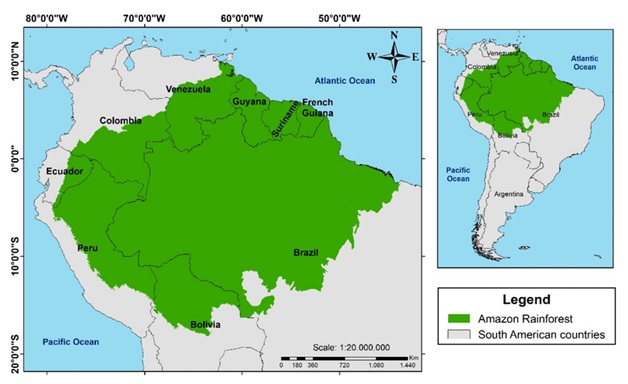Severe Drought in the Amazon Rainforests (Indian Express)

- 19 Oct 2023
Why is it in the News?
Hundreds of fish dead, no drinking water, food or other supplies — the latest spell of drought in the Amazon rainforest has disrupted the lives of tens of thousands of Indigenous people.
Amazon Rainforest Drought:
- In the period from July 2023 to September 2023, eight Brazilian states experienced the lowest rainfall in over four decades.
- Projections indicate that rainfall is expected to remain below average until the year's end.
- This recent calamity further contributes to the ongoing destruction of the Amazon, often referred to as the planet's lungs due to its role in storing over 150 billion metric tonnes of carbon.
Impact of the Drought:
- Depletion of Water Bodies: The Rio Negro, among the world’s largest rivers, registers a historic low of 13.59 meters.
- The Madeira River, a crucial Amazon tributary, experiences a decline, causing the suspension of operations at the Santo Antonio hydroelectric dam due to exceptionally low water levels.
- Loss of Marine Life: Elevated mortality among fish and river dolphins (Boto) results from the drought's impact on water levels.
- Carcasses contaminate water sources, compelling residents to use compromised water for essential activities like cooking, bathing, and drinking.
- State of Emergency and Humanitarian Concerns: Brazilian authorities express apprehension about approximately 500,000 people being affected by the end of October.
- Manaus, the largest city in Amazonas, declares states of emergency in 55 out of 62 municipalities due to acute water shortages.
- Escalation of Wildfires: The rainforest, now more susceptible due to extreme dry conditions, witnesses a surge in wildfires.
- Amazonas state records an unprecedented 2,700 blazes this month, marking the highest for October in the past 25 years.
- Deteriorating Air Quality in Manaus: Smoke from wildfires adversely impacts air quality in Manaus, a city of two million in the heart of the Amazon.
- Hazardous pollution levels pose health risks, leading to respiratory issues for children and older residents, prompting hospitalisations.
What are the Reasons Behind this Drought?
- Droughts are not unprecedented in the Amazon, with the most notable recent instance occurring in 2021, marking the driest period in at least 90 years.
- The current drought, however, appears to be even more severe, attributable to two simultaneous natural phenomena impeding cloud formation and exacerbating the already diminished rainfall levels in the region.
- Influence of El Niño: El Niño denotes an abnormal warming of surface waters in the equatorial Pacific Ocean.
- This weather pattern tends to elevate the likelihood of setting temperature records and induces heightened heat extremes across various global regions, including the ocean.
- Elevated Water Temperatures in the Atlantic Ocean: The other contributing factor is the unusually high water temperatures observed in the northern tropical Atlantic Ocean.
- Elevated ocean temperatures prompt the ascent of heated air into the atmosphere, reaching the Amazon rainforest.
- The warmth inhibits cloud formation, resulting in a substantial reduction in rainfall.
Studies Highlighting Concerns for the Future of the Amazon Rainforests:
- Numerous studies over the years have consistently warned that the Amazon faces an increased risk of prolonged and more frequent droughts due to escalating global temperatures.
- A 2022 research publication in the Proceedings of the National Academy of Sciences (PNAS) projected that if current fossil fuel consumption rates persist, the rainforest could endure significant droughts in 9 out of every 10 years by 2060.
- Another study, featured in the journal Nature in 2022, disclosed a concerning trend: Amazon's diminished ability to recover from prolonged droughts over the last two decades, bringing it dangerously close to a tipping point.
- Crossing this threshold could result in the transformation of the lush green forest into a drier open savanna, releasing substantial stored carbon and contributing to further global warming.
- With 17 to 20 percent of the Amazon destroyed in the past five decades, urgent measures are imperative to combat deforestation and greenhouse gas emissions, and where feasible, undertake reforestation initiatives in the depleted areas, as advocated by experts.
About Amazon Rainforests:
- Amazon is the world’s largest tropical rainforest covering over 5.5 million square kilometres.
- Tropical forests are closed-canopy forests growing within 28 degrees north or south of the equator.
- Due to the thickness of the canopy (the top branches and leaves of the trees), the Amazon floor is in permanent darkness.
- Tropical forests are very wet places, receiving more than 200 cm of rainfall per year, either seasonally or throughout the year.
- The Amazon is found in South America, spanning across Brazil, Bolivia, Peru, Ecuador, Colombia, Venezuela, Guyana, Suriname and French Guiana.
- Running through the north of the rainforest is the Amazon River — a network of many hundreds of waterways that stretches 6,840km.
- Around 400-500 indigenous Amerindian tribes call the Amazon rainforest home.
- It’s believed that about fifty of these tribes have never had contact with the outside world!
- The Amazon has an incredibly rich ecosystem – there are around 40,000 plant species, 1,300 bird species, 3,000 types of fish, 430 mammals and a whopping 2.5 million different insects. Wow!
- The Amazon is home to a whole host of fascinating – and deadly! – creatures, including electric eels, flesh-eating piranhas, poison dart frogs, jaguars and some seriously venomous snakes.
- This area of immense natural beauty plays an important role in limiting climate change. This is because the rich vegetation takes carbon dioxide (a greenhouse gas) out of the air and releases oxygen.
